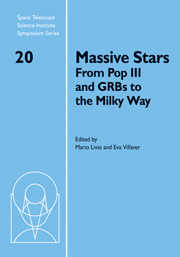Book contents
- Frontmatter
- Contents
- Participants
- Preface
- High-mass star formation by gravitational collapse of massive cores
- Observations of massive-star formation
- Massive-star formation in the Galactic center
- An x-ray tour of massive-star-forming regions with Chandra
- Massive stars: Feedback effects in the local universe
- The initial mass function in clusters
- Massive stars and star clusters in the Antennae galaxies
- On the binarity of Eta Carinae
- Parameters and winds of hot massive stars
- Unraveling the Galaxy to find the first stars
- Optically observable zero-age main-sequence O stars
- Metallicity-dependent Wolf-Rayet winds
- Eruptive mass loss in very massive stars and Population III stars
- From progenitor to afterlife
- Pair-production supernovae: Theory and observation
- Cosmic infrared background and Population III: An overview
The initial mass function in clusters
Published online by Cambridge University Press: 04 August 2010
- Frontmatter
- Contents
- Participants
- Preface
- High-mass star formation by gravitational collapse of massive cores
- Observations of massive-star formation
- Massive-star formation in the Galactic center
- An x-ray tour of massive-star-forming regions with Chandra
- Massive stars: Feedback effects in the local universe
- The initial mass function in clusters
- Massive stars and star clusters in the Antennae galaxies
- On the binarity of Eta Carinae
- Parameters and winds of hot massive stars
- Unraveling the Galaxy to find the first stars
- Optically observable zero-age main-sequence O stars
- Metallicity-dependent Wolf-Rayet winds
- Eruptive mass loss in very massive stars and Population III stars
- From progenitor to afterlife
- Pair-production supernovae: Theory and observation
- Cosmic infrared background and Population III: An overview
Summary
The stellar initial mass function (IMF) in star clusters is reviewed. Uncertainties in the observations are emphasized. We suggest there is a distinct possibility that cluster IMFs vary systematically with density or pressure. Dense clusters could have additional formation processes for massive stars that are not present in low-density regions, making the slope of the upper-mass IMF somewhat shallower in clusters. Observations of shallow IMFs in some super star clusters and in elliptical galaxies are reviewed. We also review mass segregation and the likelihood that peculiar IMFs, as in the Arches cluster, result from segregation and stripping, rather than an intrinsically different IMF. The theory of the IMF is reviewed in some detail. Several problems introduced by the lack of a magnetic field in SPH simulations are discussed. The universality of the IMF in simulations suggests that something more fundamental than the physical details of a particular model is at work. Hierarchical fragmentation by any of a variety of processes may be the dominant cause of the power-law slope. Physical differences from region to region may make a slight difference in the slope and also appear in the low-mass turnover point.
Introduction: Uncertainties
The stellar initial mass function (IMF) is difficult to measure because of systematic uncertainties, selection effects, and statistical variance. Stars in clusters may all have the same age and distance, making their masses relatively straightforward to determine, but mass segregation, field star contamination, variable extinction, and small number statistics can be problems in determining the IMF.
- Type
- Chapter
- Information
- Massive StarsFrom Pop III and GRBs to the Milky Way, pp. 93 - 103Publisher: Cambridge University PressPrint publication year: 2009



